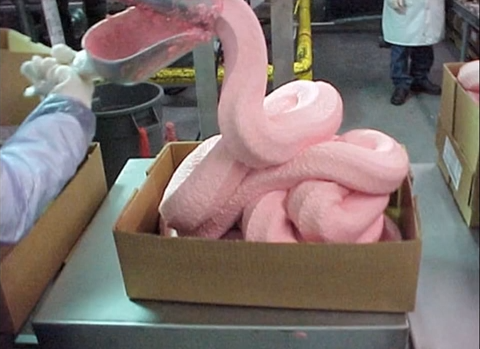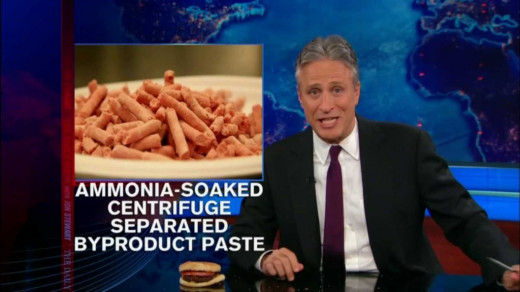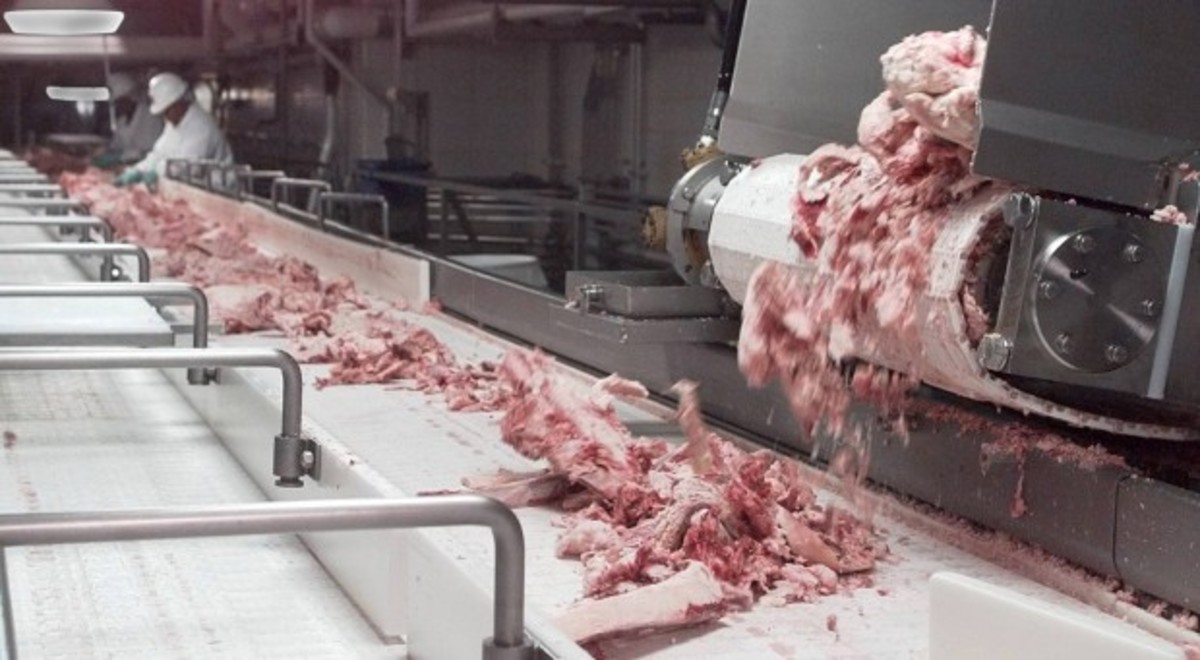Food Safety Alert - Ammonia in United States Beef and Labeling Deficiencies
On December 30th, 2009, a New York Times investigation reported that many of our beef products here in the United use ammonia in the processing of beef. Many of the hamburgers we eat at fast food restaurants have had ammonia injected for the sake of infection control and cost savings.
The story is absolutely fascinating, but it may forever change your taste buds for a hamburger at your favorite local fast food restaurant.
The end goal should be better disclosure to the consumer regarding the ingredients that our foods contain and, just as important, information on the processing and the chemicals used in the processing of food.
Pink Slime in US Beef

Ammonia Cell NH3

NY Times Reports on the Safety Beef Production
- Safety of Beef Processing Method is Questioned
"Eight years ago, federal officials were struggling to remove potentially deadly E. coli from hamburgers when an entrepreneurial company from South Dakota came up with a novel idea: injecting beef with ammonia...."
Ammonia
How is Ammonia Utilized in Other Industries - Beyond Beef?
Ammonia Definition - From Wikipedia
"Ammonia is a compound of nitrogen and hydrogen with the formula NH3....
Ammonia contributes significantly to the nutritional needs...is also a building block for the synthesis of many pharmaceuticals.
Although in wide use, ammonia is both caustic and hazardous.
Ammonia, as used commercially, is often called anhydrous ammonia. This term emphasizes the absence of water in the material."
Source: Wikipedia
Ammonia in the Beef
Ammonia in Freshwater Aquariums - From About.com
Shirlie Sharpe detailed in About.com how ammonia is consider in freshwater aquariums:
"Ammonia is a toxic substance that builds up in the aquarium, particularly in a newly setup tank. Ammonia is the first step in the nitrogen cycle..."
Source: About.com
Beef Products, Inc. - BPI Products (BPI)
On their website, Beef Products, Inc., a publicly traded company under the stock symbol, BPI, detailed the products that they process.
"BPI products are being utilized by most of the QSR (Quick Service Restaurant) chains, HRI (Hotel, Restaurant, Institution) suppliers, and food service suppliers. Additionally, BPI® Boneless Lean Beef Trimmings are commonly used by major packers and processors as an integral part of their retail ground beef or hamburger blends. BPI's product is also approved for use in the USDA’s AMS (Agricultural Marketing Service) school lunch program.
- Fresh and Frozen hamburger patties
- Fresh retail ground beef (bulk, high-OX or low-OX MAP)
- Low-fat hotdogs
- Taco meats
- Lunch meats
- Chili
- Beef stick snacks
- Sausages, pepperoni, and other encased meats
- Retail frozen entrees
- Meatballs
- Fabricated roast beef
- Canned foods"
Journal of Food Processing
Want to learn more about food processing? Here is a great website complete with journal that specifically address food production, food contamination, food processing and meat processing.
"Wiley InterScience (www.interscience.wiley.com) provides access to over 3 million articles across nearly 1500 journals and 7000 Online Books and major reference works. It also holds industry leading databases such as The Cochrane Library, chemistry databases and the acclaimed Current Protocols laboratory manuals.
Wiley InterScience is one of the world's premiere resources for study, teaching and advanced research."
Staph - Staphylococcus Aureus - Bacteria Infection
Staph (pronounced: staff) is the shortened name for staphylococcus aureus (pronounced: staf-uh-low-kah-kus sometimes denoted for some of the species as S. aureus), is a type of bacteria. Many of these bacteria are harmless and live on our skin surfaces most commonly around the nose, mouth, genitals, etc... With over 30 species of staph, many version cause infection.
Infections include food poisoning, toxic shock syndrome, boils, impetigo (sometimes denoted by blusters with pub) and cellulitis (skin inflammation often accompanied by fever, chills and muscle aches).
MRSA is one of the deadliness bacteria of the staphlococcus family of bacteria. Methicillin-resistant Staphylococcus aureus (MRSA) is a bacterial infection that is highly resistant to some antibiotics. MRSA staph skin infections cause a red, swollen, and painful area on the skin.
This is a critical topic for the consumer to thoroughly review. Therefore, I have laid this article out in three sections in order to fully understand the complexity and history of these potentially life threatening issues that demand new regulations. Follow through the ABC's of what occurred - A. What is Ammonia? Who Is Affected? How is it Used?, B. What Went Wrong? and C. Why Did This Happen?
What Happened with the Beef
The New York Times report details that labeling for ammonia was exempted. And yes, ammonia is the chemical we often clean with - it was injected into beef to provide E.coli and salmonella protection. Amazingly the consumer was never notified! Essentially, ammonia is a naturally occurring chemical and deemed part of the processing of the food not an ingredient. Upon review, I believe you will agree with me that the consumer deserves full disclosure of all ingredients - including the ingredients and the processing used in food preparation.
Ammoniated Fatty Trimmings for Hamburger Patties
Ammoniated trimmings are processed by Beef Products, Inc. This company is a major supplier to some of the world's largest food producers, such as Cargill. Our fast-food restaurants and school lunch rooms use these beef patties and other related food products for their customers and students. Beef products with less fat may not contain or even be a candidate for these potentially harmful ammoniated processes. As I detailed earlier, the questions are "which products?" and "where is the disclosure?"; food labeling needs to be changed to reflect new technology and chemicals, even "natural chemical" processes on food labels.
A. What is Ammonia? Who Is Affected? How is it Used?
Ammonia (nitrogen) is a chemical that occurs naturally and also can be produced by man (see the Harber-Bosch process devised by the Germans for World War I described in detail below). Ammonia nitrogen is often present in water as a result of the decay of plant and animal matter. Raw sewage, industrial effluents (from petroleum refineries) are other common occurrences that produce ammonia.
Who is Affected?
The mainstay of America's hamburgers is the primary use of this anti-bacterial process, which would include our quick service restaurants also known as "QSRs" (which is another term for our fast-food restaurants), grocery store chains and our federal school lunch program. The NY Times article details that the "federal school lunch program used an estimated 5.5 million pounds of the processed beef with ammonia last year alone."
How is Ammonia Utilized? Fertilizer to Pharmaceuticals and Beyond
For the beef industry, ammonia is infused into beef to provide a natural method of ridding foods of bacteria. Ammonia production is utilized extensively throughout different industries and in a number of different manners from technology products in the semi-conductor industry, ammunition to refrigeration and fertilizers. Since ammonia is a chemical, the production of ammonia is best classified in the pharmaceutical industry.
Interestingly, many food producers, especially large food producers, have vertical integration with pharmaceutical companies in some manner. Additionally, there is a synthetic ammonia - a man-made version. Amazing how man is able to copy nature!
What are the Effects of High Concentrations of Ammonia?
High Concentrations of Ammonia - Harmful to the Environment & Toxic to Aquatic Life
High concentrations of ammonia can indicate contamination from waste treatment facilities, industrial effluents or fertilizer (ammonia - nitrogen) run off.
A high concentration of ammonia has been found toxic to aquatic life.
How is Ammonia Utilized in the Beef Process
The ammonia process used in meat processing is intended to combat microbial pathogens like E. coli and salmonella as mentioned in the article. I imagine they also thought it would handle dangerous staph bacteria such as MRSA.
The process uses "low-grade beef trimmings" to fill in the 100% all beef!
Untreated beef contains ammonia at a scale of about 6 of pH level, which is near the pH of rainwater and milk. The study that won the U.S.D.A. approval was at a ph level of 10. Concern was given for products to still be palatable at a pH level of 9.5.
B. What Went Wrong?
The investigative report by New York Times details two major concerns 1.) No 3rd party testing of this ammonia process used for disinfection and 2.) Since "ammonia" is a naturally occurring chemical, labeling requirements for chemical additives was waived.
The label which we as consumers thought was government controlled stated "100 percent beef” is not in its purest form - In other words, this is not true, it is 100 percent beef, but the processing chemicals that have been used and linger should be fully disclosed. Beef, in many cases, contains "anhydrous ammonia" which has been added intentionally by the processing plant to maintain freshness and combat harmful, sometimes deadly bacteria.
Food Safety Regulations
GRAS - Generally Regarded As Safe
The standards of the United States governmental agencies, such as the Department of Agriculture, use a standard labeled "the GRAS standard". This standard has been defined in order to effectively handle administratively all new technological advances. Ammonia infusion was a process that was categorized as an acceptable standard.
What Really Happened - Behind the Scenes?
The New York Times did an exceptional job of explaining and detailing exactly what happened. In a short synopsis; Two events occurred.
Two suppliers, one of which was named in the New York Times article, has had its beef products recalled by the U.S.D.A. due to E.coli outbreaks. Interestingly, Beef Products, Inc. - the one supplier named - did not have "as wide of a recall as other Cargill suppliers".
The two events that are at issue here of course are 1.) The outbreaks of E.coli and 2.) The labeling of food products. Labeling must include full disclosure of the processing methods - not just the "ingredients" and possibly other chemicals the food has been exposed to - we already do this for peanuts which is a natural product, why not include a full disclosure also for ammonia and carbon monoxide?
C. Why Did This Happen?
The History of the Beef Products, Inc. Process & Use of Ammonia
Eldon N. Roth, founder and owner of Beef Products, Inc., spent the 1990s looking for solutions for the proliferation of bacteria problems that plague food. The road is rough and he considered many different processes from electricity running through the beef trimmings to kill bacteria to ammonia injection. Searching for what he defined as the "risk-free burger", Mr. Roth ended up settling on ammonia processing.
Roth went on to secure several patents for "over two dozen pieces of equipment and methods used in processing beef." Dr. David M.Theno, a food safety consultant, commends Mr. Roth using his skills to actively search for improvements for our food safety. In the New York Times article, Dr.Theno goes on to commend Eldon Roth for his vision.
Roth Stands Beyond the Ammonia Process
Roth gave a buy-back guarantee: "If any of the most virulent E. coli was found in ground beef containing Beef Products meat, the company would buy the tainted meat."
The FDA Endorsement of the Process - FDA Compliance
"The Food and Drug Administration signed off on the use of ammonia, concluding it was safe when used as a processing agent in foods. 'This year a top official with the U.S.D.A.'s Food Safety and Inspection Service said, "It eliminates E. coli to the same extent as if you cooked the product.'"
What Went Right?
The school lunch division of the Department of Agriculture in Washington is credited with beginning an investigation within hours of the notification of a batch of processed beef that tested positive for E.coli.
And What Went Wrong?
But the New York Times is quick to point out that the division overseeing the general public delayed its investigation for "another month and half".
C. Why Did This Happen?
Many may have read the article and assumed that this happened just for the sake of cost. If you review the full story closely by the New York Times, Eldon Roth, the founder of Beef Products, Inc. was simply trying to help the food industry and prevent sickness. Additionally, it is important to note that the food giants, such as Cargill, did shut down many operations, two of which were Beef Products, Inc. This story is much more than just dollars and cents, it is a story of new technology, government oversight and the need for the consumer to be informed.
Balancing the Odor, Alkalinity and the Safety of the Consumer
There is a sensitive balance regarding the "correct" use of ammonia. Beyond the level of 9.5 there is a distinct ammonia smell which may not be "palatable" to the consumer. The article alludes to a possible assumption that a ph level lower than 8 presents a higher risk of E.coli.
Dr. Michael P. Doyle, a food industry consultant and director for the Center for the Food Safety at the University of Georgia, stated that the level of alkalinity in beef "could have a significant effect on the antimicrobial effectiveness of the ammonia".
In order to combat the ammonia "aroma", the levels of alkalinity need to be lowered. The New York Times research samples showed a pH level as low as 7.75. Remember the testing that approved this process was at a pH level of 9.5 - 10 for alkalinity.
"The Consumer Rules"
The food industry in the United States is dominated by privately held companies, owned by various family members. One website stated it best - "the consumer rules!". What we demand as consumers, what we will pay, what disclosures we demand these companies will actively seek to deliver.
Therefore, it is critical for us, as consumers, to understand this new technology and demand full transparency. Learning what is happening to the food that we ingest and how it gets to our plates is critical. Knowing the risks of bacteria is important to protecting our health and the health of our families. Bacteria, deadly bacteria, can be found in meats and in hand to hand contact as we have learned more about MRSA. Understanding the unseen is an important element in education for personal safety and nutrition.
The Backstory - Why No Label for this Chemical Additive?
The FDA uses a standard called "Generally Recognized as Safe Substance (GRAS). Since ammonia is a naturally forming chemical in nature, it was recognized and labeled as "GRAS". Being a new processing technique and not an ingredient, the chemical processing was not deemed within their scope of items needed for disclosure. Ammonia is not the only ingredient used in "processing" of food, there is also a process which includes carbon monoxide that is present in the preparation of many frozen vegetables.
Health Media and Pink Slime

Other Deceptive Practices in the Food Industry
The food industry with its attempt to add new processing technique to help safeguard us from harmful bacteria is undergoing a metamorphosis both in operation and reporting standards, however, more work is needed.
Better education of the consumer of what goes into our food both "ingredients" and "processing" is needed. Ammoniated fatty trimmings is one issue as it another issue with "carbon monoxide".
Food Quality News reports that carbon monoxide in meats is considered deceptive by 80% of consumers.
Deficiencies in Food Labelling
The report from Food Quality News entitled "Carbon Monoxide in Meats Considered Deceptive" details that a process of infusing inert gases such as carbon monoxide, carbon dioxide and nitrogen and then heat sealing the package results in a 15 day extension of freshness to the meats and vegetables (as compared to 5 days without this process).
Fraudulent Labeling - U.S.D.A.'S Review
To the Department of the U.S.D.A.'s credit, the Times report detailed that Gerald Zirnstein, a microbiologist with the U.S.D.A. questioned the allowance of the ammonia processing in ground beef to be a form of "fraudulent labeling".
Changing the labeling mandates of the U.S.D.A. to keep up with the new technology is now fully recognized by the U.S.D.A. thanks to the thorough investigative reporting by the NY Times staff.
Department of of Agriculture
It is reassuring that the NY Times report detailed that "Within hours of confirming the contamination, the school lunch division of the Agriculture Department in Washington began investigating".
It is also helpful for the NY Times to report another department's response time was over one month - and that was the department that overseas meat for the general public.
The standards of operations among the divisions of the Department of Agriculture need closer review.
The Good News - The Food Giants Are Trying
In 2007, the NY Times reports that the food giant "Cargill, which uses more than 50 vendors suspended three facilities for excessive salmonella; two were Beef Products plants, records show." Cargill who is one of the nation's "largest hamburger makers" is also the largest privately held company as reported by Forbes in 2006. Cargill is a major customer of Beef Products, Inc.'s "ammoniated trimmings for its patties."
NY Times Investigative Efforts Recognized - A Public Service
This
information is brought to you by the investigative efforts of the New
York Times. It was through their diligence of reviewing records, sampling treated beef and speaking with regulatory officials such as the U.S.D.A., Department of Agriculture and the F.D. A., industry experts from private sector that specialize in food safety along with former microbiologists that we have learned about these new technological processes that demand new regulations and labeling for the protection of the consumer.
Beef Products - Local Meat Stores - Order Beef On Line
The good news in the food industry is many local meat stores still exist. Seek out small, family owned stores which process their own beef. Order beef on line - also, check on line for some great meat companies. Don't be shy about asking about their meat products processing. Remember they want to deliver the highest quality beef products to you - you "the consumer rule".
Should Use of Ammonia in Beef Products Be Fully Disclosed to Consumers?
Should the Use of Carbon Monoxide in Food Be Fully Disclosed to Consumers?
Summary
Technology is quickly advancing. As technology moves forward, we as consumers need an education of the processes that take place in order to make better decisions about our health and the health of our families.
Understanding the unseen, understanding bacteria in food and in our environment are critical health items. Demanding full disclosure of new processing techniques is needed by the consumer.
New labeling mandates are needed but perhaps new techniques are needed. The all natural food sanitizers are an options to be strongly considered.
In summary, the food giants are concerned. The regulatory agencies are concerned. We, the consumer need to show up and be counted for in our choices.
Ask the Questions - Demand the Answers
Ask the questions, demand the answers, shop at the local meat shops, spend the money now to know what is in your food. Local butchers in my area exist and can be counted upon to give clear answers.
Love this website and wish to join us?








